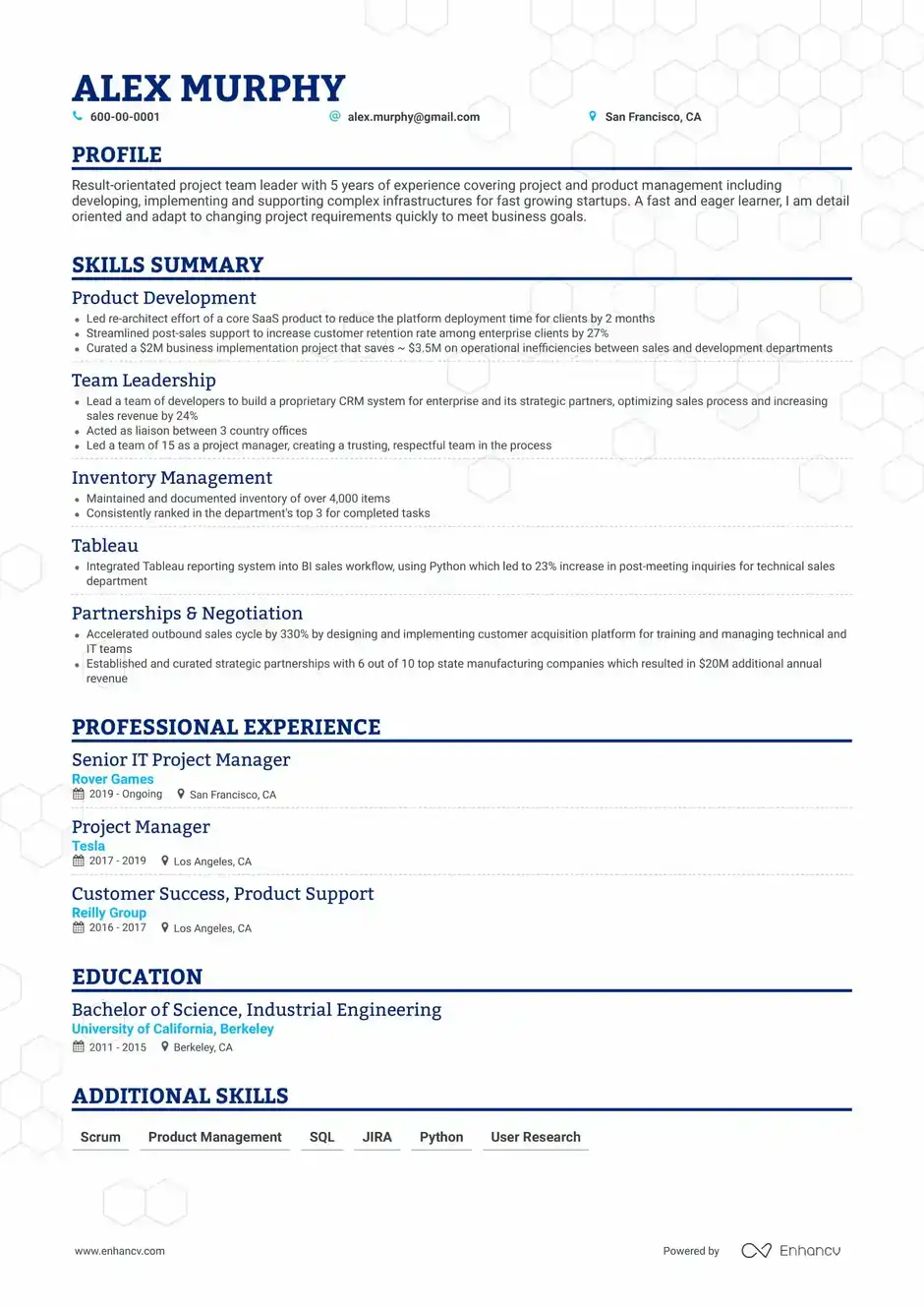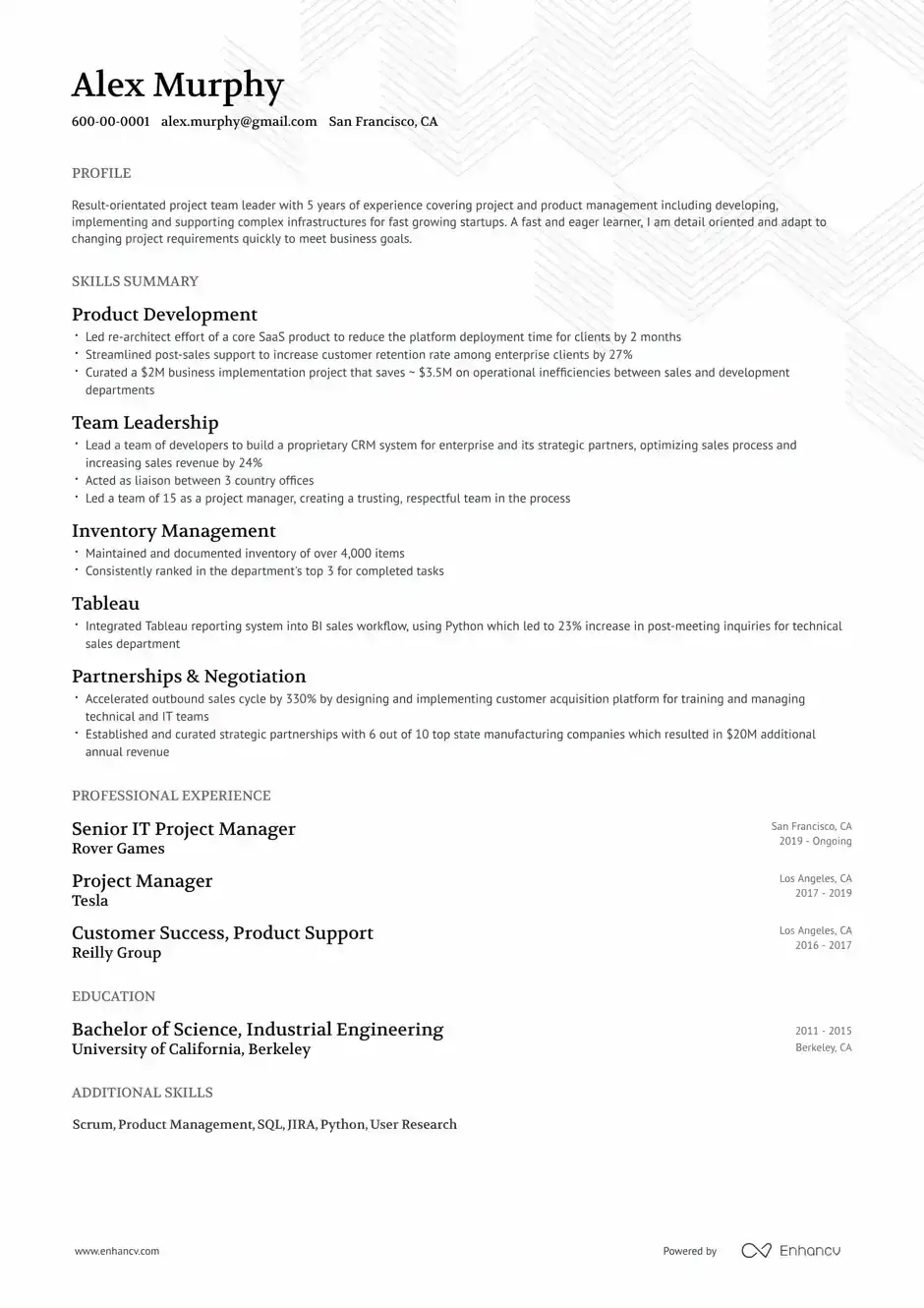What is a Functional resume template?
A functional resume template is a fantastic option for anyone who’s starting their career or switching to a different field. The focus is on your professional skills rather than your work history.
Functional resume templates are a format that groups your experience under skill categories instead of job titles to emphasize transferable skills by listing examples of your abilities from both work and personal experiences.
Functional resumes are perfect for highlighting your experience and are easy to write with our already made template structure.
When to use functional resume template?
With their specific structure, functional resumes put in the center your skills and achievements. After your contact information, you go straight into your most relevant abilities and accomplishments, and then you can give brief details about your job history.
That’s why this format is preferable by people with employment gaps, military experience, or entry-level.
Functional Resumes are also perfect for jobseekers who are switching industries or want to take a new direction in their career path. The main purpose of this resume template is to put into light your skillset, especially if you apply to a different industry. In this case, emphasizing your transferable skills can help you land a new job.
Unfortunately, a functional resume, as attractive as it can be to some jobseekers, can cause suspicion in recruiters, because of the presented information, which can be taken out of context. That’s why some recruiters prefer a combination between functional and reverse-chronological resume.
But still, there are so many good reasons to use this formatting if you do it right. Check our guide on how to write a resume.
Tips to build the best functional resume:
Functional resume or skill based structure can be used with the modern design template or the classical one. It will depend only on your personality, experience, and the type of business industry you are applying to. Let’s begin to create the best functional resume, so you can get the job of your dreams:
Design
Take the best from both worlds. You can use some features from the modern design and the traditional one. Keep your resume clean from unnecessary graphics. Use icons only to pop up your skills and achievement sections. Each section on your resume is arranged in blocks to emphasize the important information - your accomplishments and abilities. You can be inspired by some of the best resume designs.
Font
Your resume should be easily readable. That’s why you should choose your font carefully. The best fonts are those that have enough white space to read well on both screens and print, it will make your resume easier to scan/read. Enhancv’s functional resume template uses Lato for all headings, subheadings, and body text. And while the body of the text is consistent in size throughout, the resume headings are large enough to catch the readers' eye.
Colors
Using black, white, and a third color like blue or green is a safe resume color scheme. That’s why we are using a splash of blue to help draw attention without being distracting. The general rule is to make one color dominant, one secondary, and the third to place emphasis. Use white for the background, black for the text, and the third color to highlight important parts like heaters for the differed sections.
Select the best layout
A functional resume follows a skill-based structure to emphasize your strengths and achievements, which are one of the first things to list. The resume features several sections: heading, summery, strengths, achievements, experience, and education.
Of course, you start your resume from the header, where you can list your name and contact information. Your name is the biggest thing on the resume to ensure you stand out. It’s always better to add something more about yourself, as a link to your profile in professional networks or if you have a portfolio website that is appropriate to share. Headshot’s not a must to include, but if the recruiters specifically mention it in the job application, you should add it at the header near your name and contact information.
The summary in functional resume looks a little-bit different. The focus here is to highlight your skills and achievements, allowing you to describe your qualifications with more details using strong action verbs. If you have gaps in your employment history or other problems, here is the place to explain them. Use the summary to illustrate to the recruiters why you're qualified for the position.
The next step is the key sections on your functional resume. Strengths and achievements are featured first to show recruiters what sets you apart from other candidates. In the first section, list and give examples of your transferable skills like time management, problem-solving, interpersonal skills, organization, leadership, and so on. Emphasize these strengths, giving examples of what you accomplish by applying this skillset to your previous jobs, personal situations, or academic life in the achievement section.
A functional resume is focused on your experience and skills, in the education section you can list the basic facts regarding your degree, including institution name, location, degree, and major. If you don’t have any previous work experience, you should spend more time on the education section by providing more details on your courses if relevant to the job you are applying for. You can check our guide for resumes without work experience.
Another section that you can add to your functional resume is information about your certifications. Especially in the cases in which you decided career change and took professional retraining courses to enable you to do the job you are applying for. It’s essential to mention this certification on top of your resume in the summary section, or you risk the recruiter just skipping over your resume and missing this information.
As additional section and information that you can add if applicable to your resume can be - special awards or commendations; testimonials from clients; volunteer work; projects; publications, or special courses. You can list them by importance and significance in separate sections. Name each of your sections, then add a short description below
Number of pages
Keep your resume between one or two full pages. Your application’s length should be determined by the position you’re applying for and the amount of relevant experience you have. If you are an entry level candidate or fresh graduate, you can fill up one page effortlessly. It’s your choice how to arrange all the sections - in one or two columns. Functional resumes are very flexible and can give you a lot of freedom to creatively shape your resume on one or two pages.
Your talent determines what you can do. Your motivation determines how much you are willing to do. Your attitude determines how well you do it.
- Lou Holtz, Former American football player and coach
Functional Resume Template Pros and Cons
PROS
- A functional resume is the right choice for candidates with non-traditional work experience or no work experience entirely.
- A functional resume emphasizes your skills and accomplishments. It is an effective way to tell your career story if you have a lot of experience and want your goal is to showcase your accomplishments.
- It is easy to adjust the content to a specific role you’re hoping to land without thinking much about job titles that aren’t relevant to the job application, employment gaps, or lack of experience in the field
CONS
- More experienced recruiters don’t like this type of resume formatting because your skills and achievements are laid out without context.
- Some recruiters will skip to the part of your work experience and education and entirely miss evening else.
- Functional resumes aren’t very common, which can lead to confusion, and the recruiter might have a hard time scanning and understanding this alternative formatting








